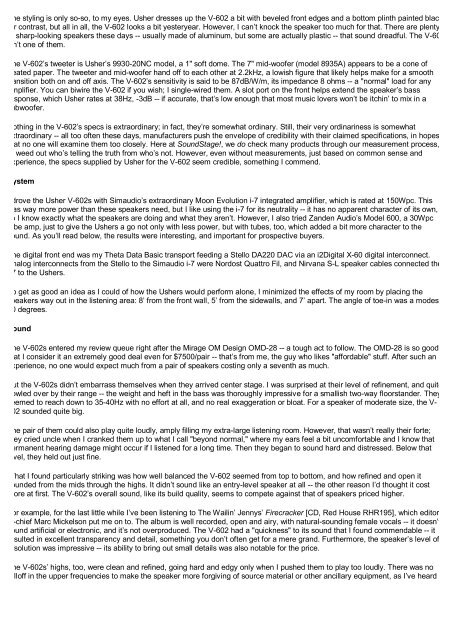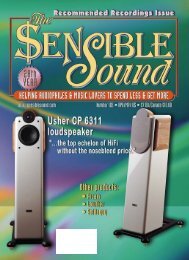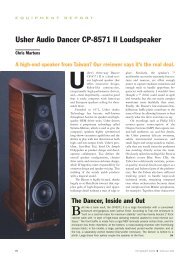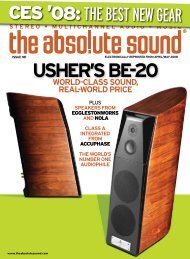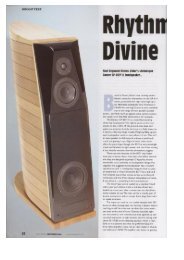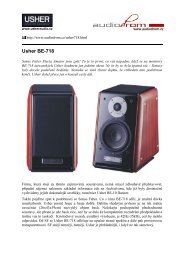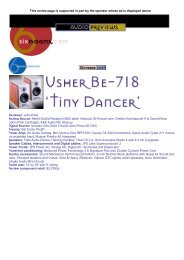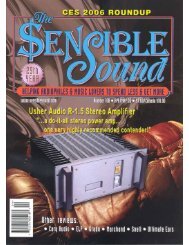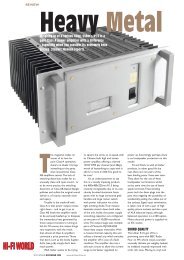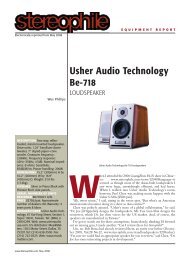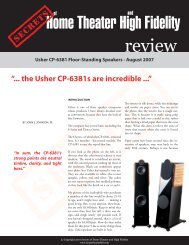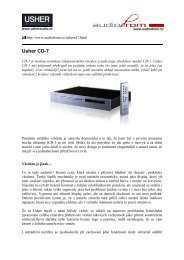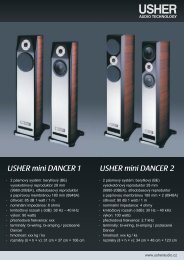22USHER V-602, TEST v SoundStage 2007 - USHER Audio ...
22USHER V-602, TEST v SoundStage 2007 - USHER Audio ...
22USHER V-602, TEST v SoundStage 2007 - USHER Audio ...
Create successful ePaper yourself
Turn your PDF publications into a flip-book with our unique Google optimized e-Paper software.
The styling is only so-so, to my eyes. Usher dresses up the V-<strong>602</strong> a bit with beveled front edges and a bottom plinth painted black<br />
for contrast, but all in all, the V-<strong>602</strong> looks a bit yesteryear. However, I can’t knock the speaker too much for that. There are plenty<br />
of sharp-looking speakers these days -- usually made of aluminum, but some are actually plastic -- that sound dreadful. The V-<strong>602</strong><br />
isn’t one of them.<br />
The V-<strong>602</strong>’s tweeter is Usher’s 9930-20NC model, a 1" soft dome. The 7" mid-woofer (model 8935A) appears to be a cone of<br />
treated paper. The tweeter and mid-woofer hand off to each other at 2.2kHz, a lowish figure that likely helps make for a smooth<br />
transition both on and off axis. The V-<strong>602</strong>’s sensitivity is said to be 87dB/W/m, its impedance 8 ohms -- a "normal" load for any<br />
amplifier. You can biwire the V-<strong>602</strong> if you wish; I single-wired them. A slot port on the front helps extend the speaker’s bass<br />
response, which Usher rates at 38Hz, -3dB -- if accurate, that’s low enough that most music lovers won’t be itchin’ to mix in a<br />
subwoofer.<br />
Nothing in the V-<strong>602</strong>’s specs is extraordinary; in fact, they’re somewhat ordinary. Still, their very ordinariness is somewhat<br />
extraordinary -- all too often these days, manufacturers push the envelope of credibility with their claimed specifications, in hopes<br />
that no one will examine them too closely. Here at <strong>SoundStage</strong>!, we do check many products through our measurement process,<br />
to weed out who’s telling the truth from who’s not. However, even without measurements, just based on common sense and<br />
experience, the specs supplied by Usher for the V-<strong>602</strong> seem credible, something I commend.<br />
System<br />
I drove the Usher V-<strong>602</strong>s with Simaudio’s extraordinary Moon Evolution i-7 integrated amplifier, which is rated at 150Wpc. This<br />
was way more power than these speakers need, but I like using the i-7 for its neutrality -- it has no apparent character of its own,<br />
so I know exactly what the speakers are doing and what they aren’t. However, I also tried Zanden <strong>Audio</strong>’s Model 600, a 30Wpc<br />
tube amp, just to give the Ushers a go not only with less power, but with tubes, too, which added a bit more character to the<br />
sound. As you’ll read below, the results were interesting, and important for prospective buyers.<br />
The digital front end was my Theta Data Basic transport feeding a Stello DA220 DAC via an i2Digital X-60 digital interconnect.<br />
Analog interconnects from the Stello to the Simaudio i-7 were Nordost Quattro Fil, and Nirvana S-L speaker cables connected the<br />
7 to the Ushers.<br />
To get as good an idea as I could of how the Ushers would perform alone, I minimized the effects of my room by placing the<br />
speakers way out in the listening area: 8’ from the front wall, 5’ from the sidewalls, and 7’ apart. The angle of toe-in was a modest<br />
10 degrees.<br />
Sound<br />
The V-<strong>602</strong>s entered my review queue right after the Mirage OM Design OMD-28 -- a tough act to follow. The OMD-28 is so good<br />
that I consider it an extremely good deal even for $7500/pair -- that’s from me, the guy who likes "affordable" stuff. After such an<br />
experience, no one would expect much from a pair of speakers costing only a seventh as much.<br />
But the V-<strong>602</strong>s didn’t embarrass themselves when they arrived center stage. I was surprised at their level of refinement, and quite<br />
bowled over by their range -- the weight and heft in the bass was thoroughly impressive for a smallish two-way floorstander. They<br />
seemed to reach down to 35-40Hz with no effort at all, and no real exaggeration or bloat. For a speaker of moderate size, the V-<br />
<strong>602</strong> sounded quite big.<br />
The pair of them could also play quite loudly, amply filling my extra-large listening room. However, that wasn’t really their forte;<br />
they cried uncle when I cranked them up to what I call "beyond normal," where my ears feel a bit uncomfortable and I know that<br />
permanent hearing damage might occur if I listened for a long time. Then they began to sound hard and distressed. Below that<br />
level, they held out just fine.<br />
What I found particularly striking was how well balanced the V-<strong>602</strong> seemed from top to bottom, and how refined and open it<br />
sounded from the mids through the highs. It didn’t sound like an entry-level speaker at all -- the other reason I’d thought it cost<br />
more at first. The V-<strong>602</strong>’s overall sound, like its build quality, seems to compete against that of speakers priced higher.<br />
For example, for the last little while I’ve been listening to The Wailin’ Jennys’ Firecracker [CD, Red House RHR195], which editor<br />
-chief Marc Mickelson put me on to. The album is well recorded, open and airy, with natural-sounding female vocals -- it doesn’t<br />
sound artificial or electronic, and it’s not overproduced. The V-<strong>602</strong> had a "quickness" to its sound that I found commendable -- it<br />
resulted in excellent transparency and detail, something you don’t often get for a mere grand. Furthermore, the speaker’s level of<br />
resolution was impressive -- its ability to bring out small details was also notable for the price.<br />
The V-<strong>602</strong>s’ highs, too, were clean and refined, going hard and edgy only when I pushed them to play too loudly. There was no<br />
rolloff in the upper frequencies to make the speaker more forgiving of source material or other ancillary equipment, as I’ve heard


